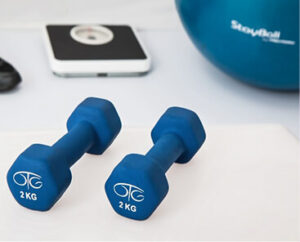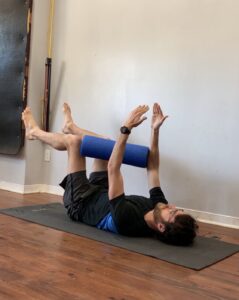Is Your Strength Training Paying Off?
Thinking critically about strength training. Not all strength training is the same!

By Garrett de Jong
My strength training looks a lot different these days. Ten years ago, I would go to the university gym and do the classic stuff: squats, deadlifts, bench press etc. Sure I got stronger but I still got injured. My strength work didn’t support my sports (triathlon, running) as much as people were claiming it would!
Strength training (ST) gets a lot of praise. As a therapist and run coach, many of my clients and athletes want to do it and I often do prescribe it. But ST (or at least the way we traditionally strength train) may not always be the (best) answer. In my opinion, strength training is often overrated but also underrated! Huh?! Let me explain!
What is strength training anyways?? Is it going to the gym? Using machines, DBs, or KBs? It is running hills? Is it doing body weight exercises? Is it doing yard work or working on a home renovation project?
Strength is defined as “the capacity to withstand great force or pressure.” Nowhere does it say we need to lift barbells, do push ups or stand on a bosu ball (not that there’s anything wrong with any of these!). It just needs to be something to improve our capacity. It’s that SIMPLE.
Yes you can continue to do squats and glute bridges. But maybe you can start working on ‘freeing’ your pelvis so that your glutes can do what they were designed to do. This will then in turn ‘activate’ your glutes with EVERYTHING that needs them. No longer will you need to worry about forgetting to squeeze your glutes when you walk or run! (Pre run checklist: put shoes on 




My new definition of ST is simply working on our weakest or missing link(s)! And this ST can be achieved in many ways and is guaranteed to lead to results.
I think it is important to go over what it is we want to achieve through ST anyways? Generally, two things:
– Injury prevention? (Improve capacity of tissue to withstand breaking down)
– Performance gains. (Improve efficiency of stride length x stride frequency)
Traditional ST may actually limit your movement potential. Therefore, not doing a great job preventing injury or improving performance. It prioritizes more loading, more stability, more weight, more reps. But unfortunately more isn’t better, BETTER is BETTER!
Let’s take the core stability vs core mobility example. Many trainers will talk about needing to stabilize the core to prevent injury and improve performance. However the movement in our core region was put there for a reason! Joints are made to move, not to stay static. Joint movement gives muscles something to do. So true core stability isn’t possible without core mobility. Working on core mobility will allow us to be more centered and automatically improve our strength and stability.
Traditional ST that prioritizes stability and loading may reinforce poor movement due to compensation developed from habits, injuries, lack of overall movement. As a result we aren’t really working our weakest link, we are following the path of least resistance, and strengthening what is already strong!
We can get faster by working on our weakest link, we avoid injury by strengthening our weakest link. I’m no engineer but if a bridge is about to collapse you don’t repave the asphalt when a pillar is wearing out!
My new definition of strength training is simply working on our weakest or missing link(s)!
David Grey, physical therapist and international performance coach, believes traditional ST often impairs athletes mobility and fluidity. He often gives the example of how a pelvis trained by a traditional squat experiences very little movement, while in an efficient gait cycle the pelvis is required to move dynamically in 3 dimensions. Check out David and Just Fly Sports for more on this.
Below are some pros/cons of ST.
- Risks with ST:
- Increases load – increase injury risk if done ‘too much too soon’
- Can reinforces poor biomechanics (which may actually be a short term benefit but inhibit long term health/performance)
- Excessive pushing, less yielding. Too much yang, not enough ying. Too much sympathetic, not enough parasympathetic 🙂
- Pros of ST:
- Can reinforce good mechanics
- Can improve MSK capacity (lower threshold for injury, increases training capacity)
- Adds variability to the system, new stimulus (although sometimes less variability than we think).
- Recommendations:
- Don’t just add traditional ST mindlessly because someone told you to do it – make sure you’re absorbing it effects. ST stress counts as overall stress too! Start slow and progress slowly!
- ST can be a lot of things! Try something, anything new and your body will need to strengthen from the experience.
- Work on your lowest hanging fruit!
- Keep things simple.
- Include variability.
- Expose yourself to awkward movement.
- Make easy movements hard! Slow things down. Avoid compensations.
- For example, I can mindlessly do squats where I naturally shift to the right. This will strengthen my right side more which isn’t necessarily a bad thing. OR I can take the approach they take in Anatomy in Motion and slow things down, doing subtle but deep movements to encourage my left side to experience more load. This will encourage my body to be more centered with will accomplish the goals of strength training (injury prevention and performance).




Since realizing that many of the goals of traditional ST can be achieved with other forms of movement interventions, my ST looks very different from my university days. After identifying my true movement restrictions and weaknesses, such as being stuck pronated in my left foot and a restricted thoracic spine (surely connected!), I now spend my time addressing these. It’s simply working on what Gary Ward’s Anatomy in Motion calls ‘What’s missing?’ – working on what renown chiropractor Dr. Craig Liebenson calls ‘the lowest hanging fruit’. Working on your restrictions will facilitate a more balanced body, and a more balanced body will always be a stronger, more robust body!
Thanks for reading! Feel free to email me with any comments or questions!
Ps. ST is simply working on your weaknesses. Step 1 is to truly be aware of our true limitations. The body is marvellous at compensating around these. Begin by becoming more self aware and start to move honestly. Want to learn more? Grap a coffee and read my friend Monika’s blog post!
Garrett